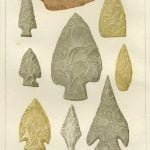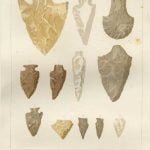
A great variety of these ancient instruments was fabricated, according to the species of hunting, the size and ferocity of the animals pursued, and the ages of the persons using them. Boys were always furnished with small arrow-points, such as were expected to be spent against squirrels, or the lesser quadrupeds and birds. This was the second lesson in learning the art of hunting; the first consisted in using the blunt arrow or Beekwuk, 1 which was fired at a mark. Great complacency and pride was evinced by the parents in preparing the rising generation for this art, on expertness in which so much of his future success depended; and a boy s first success in killing a bird or quadruped, was uniformly celebrated by a festival, in which the object killed was eaten, with great gravity, by the elders, and the feat extravagantly extolled. Thus early was emulation excited.

Of the various kinds of arrows picked up in the fields and woods, we introduce the figures of several, numbered and classified agreeably to their sizes and uses. The smallest of these, or boy s arrow of the first class, does not exceed, but often falls below, one inch, besides the shaft, in length: from this they vary to three and a quarter inches. In breadth and the form of the barb there was also much variety, and an entire and ingenious adaptedness of the instrument to the object. Figures 1 to 9, Plate 17, and 1 to 12, Plate 18, exhibit this variety. Of Plate 18, Figures 4 and 5, and 8 to 12 respectively, are drawings of specimens deposited in the collection of the National Institute, at Washington. The use of the arrow, among the early nations of mankind, is so ancient that history is at fault in fixing its date. There is reason to believe that it was coincident with the origin of war, and with the killing of animals. The instrument, in connection with the bow, is first mentioned in the Bible, in Genesis. The paintings found in the ruins of Nineveh, and the earliest dates of mankind, prove its antiquity in war and hunting; and, although the invention of gunpowder has led to far more efficacious and powerful means of destruction in war and sieges, it admits of no question, that the bow and arrow are still the most speedy and efficacious instruments for the repetition of the onslaught on droves of animals. It is the testimony of hunters, white and red, in our day, that arrows can be discharged much faster, and more fatally, from the quiver and bow, upon herds of animals, than it is possible to load and fire balls from a single gun or rifle. An arrow from the bow of a Pawnee or Cheyenne has been known to pass through the body of a buffalo. Its force upon the human frame is prodigious; as an instance of which I mention, that in some old bones, at Saganaw, an unextracted arrow-head was found firmly imbedded in the tibia of a man, nor could any force detach it.
The material of American arrows is generally a conchoidal chert, hornstone, or common quartz. In color it varies from light yellow, to neutral, smoky, or dark brown. The quartz, where that occurs, is usually of the fatty variety, and perfectly white. Pure flint has seldom, if ever, been found.
Citations:
- This specimen is preserved in the cabinet of curiosities of Miss Crooks, of Dundas; to whose politeness I owe the favor of being permitted to copy this, and some other antiquities.[
]
